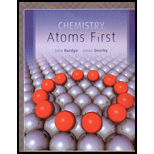
(a)
Interpretation:
The rate of the hydrogen gas evolution will be increased, decreased, or unchanged with the given information has to be stated.
Concept introduction:
Reaction: Substances which are mutually involved each other in a chemical process and changed into different substances.
To state the rate of the hydrogen gas evolution will be increased, decreased, or unchanged when 6g of powdered
(b)
Interpretation:
The rate of the hydrogen gas evolution will be increased, decreased, or unchanged with the given information has to be stated.
Concept introduction:
Reaction: Substances which are mutually involved each other in a chemical process and changed into different substances.
Rate of reaction: It represents the speed at which a chemical reaction runs. How much concentration of reactants consumed and how much concentration of product formed in a unit of time is said to be rate of reaction.
To state the rate of the hydrogen gas evolution will be increased, decreased, or unchanged when 4g of granulated
(c)
Interpretation:
The rate of the hydrogen gas evolution will be increased, decreased, or unchanged with the given information has to be stated.
Concept introduction:
Reaction: Substances which are mutually involved each other in a chemical process and changed into different substances.
Rate of reaction: It represents the speed at which a chemical reaction runs. How much concentration of reactants consumed and how much concentration of product formed in a unit of time is said to be rate of reaction.
To state the rate of the hydrogen gas evolution will be increased, decreased, or unchanged when 2M acetic acid is used instead of 2M
(d)
Interpretation:
The rate of the hydrogen gas evolution will be increased, decreased, or unchanged with the given information has to be stated.
Concept introduction:
Reaction: Substances which are mutually involved each other in a chemical process and changed into different substances.
Rate of reaction: It represents the speed at which a chemical reaction runs. How much concentration of reactants consumed and how much concentration of product formed in a unit of time is said to be rate of reaction.
To state the rate of the hydrogen gas evolution will be increased, decreased, or unchanged when temperature is raised to
Want to see the full answer?
Check out a sample textbook solution
Chapter 19 Solutions
CHEMISTRY:ATOMS FIRST-W/ACCESS>CUSTOM<
- Express the rate of the reaction 2N2O(g)2N2(g)+O2(g) in terms of (b) [ N2O ] (a) [ O2 ]arrow_forwardBacteria cause milk to go sour by generating lactic acid. Devise an experiment that could measure the activation energy for the production of lactic acid by bacteria in milk. Describe how your experiment will provide the information you need to determine this value. What assumptions must be made about this reaction?arrow_forwardCan a reaction mechanism ever be proven correct? Can it be proven incorrect?arrow_forward
- 11.44 A possible reaction for the degradation of the pesticide DDT to a less harmful compound was simulated in the laboratory. The reaction was found to be first order, with k = 4.0 X 10_H s"' at 25°C. What is the half-life for the degradation of DDT in this experiment, in years?arrow_forwardDefine stability from both a kinetic and thermodynamic perspective. Give examples to show the differences in these concepts.arrow_forwardThe hydrolysis of the sugar sucrose to the sugars glucose and fructose, C12H22O11+H2OC6H12O6+C6H12O6 follows a first-order rate equation for the disappearance of sucrose: Rate =k[C12H22O11] (The products of the reaction, glucose and fructose, have the same molecular formulas but differ in the arrangement of the atoms in their molecules.) (a) In neutral solution, k=2.11011s1 at 27 C and 8.51011s1 at 37 C. Determine the activation energy, the frequency factor, and the rate constant for this equation at 47 C (assuming the kinetics remain consistent with the Arrhenius equation at this temperature). (b) When a solution of sucrose with an initial concentration of 0.150 M reaches equilibrium, the concentration of sucrose is 1.65107M . How long will it take the solution to reach equilibrium at 27 C in the absence of a catalyst? Because the concentration of sucrose at equilibrium is so low, assume that the reaction is irreversible. (c) Why does assuming that the reaction is irreversible simplify the calculation in pan (b)?arrow_forward
 Chemistry: Principles and PracticeChemistryISBN:9780534420123Author:Daniel L. Reger, Scott R. Goode, David W. Ball, Edward MercerPublisher:Cengage Learning
Chemistry: Principles and PracticeChemistryISBN:9780534420123Author:Daniel L. Reger, Scott R. Goode, David W. Ball, Edward MercerPublisher:Cengage Learning Principles of Modern ChemistryChemistryISBN:9781305079113Author:David W. Oxtoby, H. Pat Gillis, Laurie J. ButlerPublisher:Cengage Learning
Principles of Modern ChemistryChemistryISBN:9781305079113Author:David W. Oxtoby, H. Pat Gillis, Laurie J. ButlerPublisher:Cengage Learning Chemistry for Engineering StudentsChemistryISBN:9781337398909Author:Lawrence S. Brown, Tom HolmePublisher:Cengage Learning
Chemistry for Engineering StudentsChemistryISBN:9781337398909Author:Lawrence S. Brown, Tom HolmePublisher:Cengage Learning Chemistry for Engineering StudentsChemistryISBN:9781285199023Author:Lawrence S. Brown, Tom HolmePublisher:Cengage Learning
Chemistry for Engineering StudentsChemistryISBN:9781285199023Author:Lawrence S. Brown, Tom HolmePublisher:Cengage Learning Chemistry by OpenStax (2015-05-04)ChemistryISBN:9781938168390Author:Klaus Theopold, Richard H Langley, Paul Flowers, William R. Robinson, Mark BlaserPublisher:OpenStax
Chemistry by OpenStax (2015-05-04)ChemistryISBN:9781938168390Author:Klaus Theopold, Richard H Langley, Paul Flowers, William R. Robinson, Mark BlaserPublisher:OpenStax Chemistry: An Atoms First ApproachChemistryISBN:9781305079243Author:Steven S. Zumdahl, Susan A. ZumdahlPublisher:Cengage Learning
Chemistry: An Atoms First ApproachChemistryISBN:9781305079243Author:Steven S. Zumdahl, Susan A. ZumdahlPublisher:Cengage Learning





